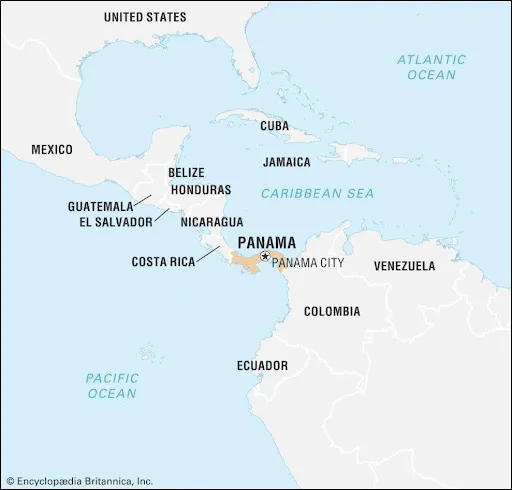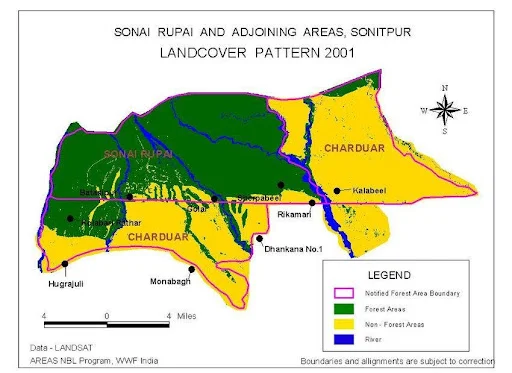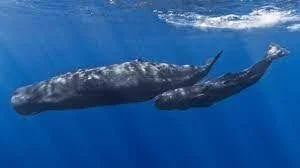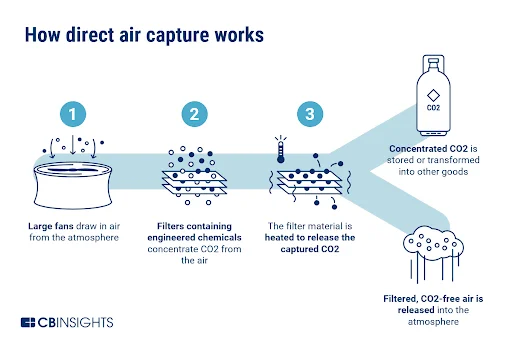GS Paper 1
Panama
- News: The incoming president of Panama has vowed to make big changes to help alleviate the U.S. border crisis.
- Central American Position: Panama is situated on the Isthmus of Panama, serving as a narrow land bridge connecting North and South America.

- Borders and Surroundings: It shares borders with Costa Rica and Colombia.
- It is positioned between the Caribbean Sea and the North Pacific Ocean.
- The country encompasses over 1,600 islands along its Atlantic and Pacific coastlines.
- Key Landmarks and Features
- Panama Canal:
- Renowned globally, Panama is recognized for the Panama Canal, a significant waterway that traverses its midsection.
- It facilitates maritime transportation between the Atlantic and Pacific Oceans.
- Diverse Ecosystems: Panama has diverse ecosystems, including the largest rainforest in the Western Hemisphere outside the Amazon Basin.
- Cultural Diversity: It comprises of indigenous peoples, Europeans, Afro-Caribbeans, and immigrants from various parts of the world.
- Language: Spanish
- Capital City: Panama City
Hindon River
- News: UP Pollution Control Board (UPPCB) has initiated criminal proceedings against urban local body officials in Ghaziabad over Hindon river pollution.
- Geographical Context: Hindon River serves as a significant tributary of the Yamuna River and is predominantly sustained by rainfall.
- Origin and Course:
-
- It originates from the lower Shivalik ranges situated in the Saharanpur District of Uttar Pradesh.
- It traverses approx 400 kilometers across the industrial belt of Western Uttar Pradesh before converging with the Yamuna River in Noida.
- Tributaries: Hindon River is supplemented by tributaries such as the Kali (West) River and Krishni River, which contribute to its overall flow.
- Environmental Challenges:
- Despite its ecological importance, Hindon River faces severe pollution due to the discharge of untreated urban, agricultural, and industrial waste.
- Consequently, it has become one of the most polluted stretches within the Ganga basin, posing significant environmental and public health concerns.
- In 2015, the Central Pollution Control Board (CPCB) found the Hindon’s pollution levels were so severe that it was declared a ‘dead river’ and ‘unfit’ even for bathing in several sections of the river.
UPSC Current Affairs: Coastal Erosion, NCRB Crime Report, Free Digital Tools, Global Climate
GS Paper 2
History Sheets
- News: The Supreme Court has instructed all states and Union Territories to ensure that police “history sheets” are free from any indication of caste biases.
- Definition: In police terminology, a history sheet refers to an individual with an extensive criminal record, having been involved in multiple criminal offenses.
- History: The term history sheet appeared for the first time in the Punjab Police Rules of 1934.
- Criteria for History Sheeting:
- Multiple Offenses or Continuous Criminal Activity: An individual can be “history sheeted” based on their involvement in multiple criminal cases or their consistent engagement in criminal activities.
- Assessment of Societal Danger: Additionally, the police may initiate history sheeting based on an ongoing assessment of the individual’s potential threat to society.
- Contents of a History Sheet: Include individual’s appearance, his associates, property ownership and mode of earning a livelihood.
- Types of History Sheets:
- Known Depredators (KD) Sheets: These are created for criminals convicted of serious crimes like dacoity, robbery, or burglary, helping in tracking their activities and associations.
- Rowdy Sheets: Rowdy sheeters are individuals known for habitually committing or aiding in offenses related to breaching peace, facilitating monitoring and preventive actions.
- Suspect Sheets: Created for individuals previously convicted of offenses such as burglary or theft, aiding in keeping track of their activities and potential involvement in similar crimes.
- Initiation Process:
- Governance by Police Rules: The procedure for opening a history sheet is governed by the police rules specific to each state.
- For example, the Punjab Police Rules, 1934 apply in regions such as Punjab, Haryana, Himachal Pradesh, Delhi, and Chandigarh.
- Station House Officer (SHO): The process commences when SHO who heads the police station, identifies an individual with a history of criminal involvement or continuous engagement in criminal activities.
- Documentation and Reporting
- Report Submission: Following identification, a comprehensive report containing detailed information about the individual, their associates, and known relatives is compiled.
- Submission to Senior Police Officials: This report is then submitted to the Senior Superintendent of Police or Superintendent of Police of the respective district, facilitated by the Assistant Commissioner of Police.
Central Insecticides Board and Registration Committee (CIBRC)
- News: In India, pesticides are regulated by the Ministry of Agriculture and Farmers Welfare through the Central Insecticide Board and Registration Committee (CIB & RC).
- Establishment: CIBRC is a regulatory body founded under the Insecticide Act of 1968.
- It holds responsibility for overseeing the registration and regulation of insecticides across India.
- Parent Body: It operates under the Ministry of Agriculture and Farmers Welfare, Government of India.
- Objective:
-
- CIBRC aims to ensure the safety and effectiveness of insecticides utilized in agriculture, public health, and other sectors.
- Additionally, it strives to encourage the sustainable usage of these chemicals.
- Operational Structure:
- Under the Insecticide Act, the registration of pesticides is mandatory at the Central level.
- Meanwhile, licenses for their manufacture, formulation, and sale are managed at the State level.
Read also: Key Events, Initiatives, and Movements Against British Rule in India
GS Paper 3
Foot Rot Disease
-
- News: Punjab Agricultural University in Ludhiana introduces Trichoderma asperellum, a biocontrol solution to tackle the foot rot disease commonly found in Basmati rice varieties.
- Bakanae Disease: It’s a fungal disease striking Basmati rice crops, primarily during the seedling phase.
- Cause: Fusarium verticillioides, a soil-seed borne pathogen, initiates the infection via the plant’s roots, eventually infesting the stem base.
- Symptoms: Infected plants exhibit abnormal height, thin and pale leaves, reduced tillering, and produce either partially filled or empty grains.
- Management Strategies:
- Seedlings are presently treated with Trichoderma harzianum pre-sowing and transplantation.
- Seeds also undergo treatment with fungicides like Sprint 75 WS (carbendazim + mancozeb) prior to sowing.
- Challenges:
- Chemical treatments pose risks to soil health and may be toxic to rice consumers.
- For instance, carbendazim, a fungicide, is banned in Punjab due to its high residue levels.
- Trichoderma Asperellum
-
- Biocontrol Agent: Trichoderma asperellum offers a non-chemical solution as an alternative to conventional pesticides.
- Action Mechanism: T. asperellum combats various plant pathogens, encompassing fungi and bacteria.
Maillard Reaction
- News: The Maillard Reaction elucidates the intricate chemical processes behind the development of flavors, aromas, and textures in food.
- Maillard Reaction: It is a sophisticated chemical interaction occurring between amino acids, the fundamental components of proteins, and reducing sugars, which are sugars capable of donating electrons, especially under heat.
-
- Effects: This reaction is accountable for the browning phenomenon and contributes significantly to the array of delightful flavors and aromas discernible in cooked foods.
- Origin: Named after the pioneering French chemist Louis-Camille Maillard, who elucidated its workings during the early 20th century.
- Illustrative Examples:
-
- Baking bread yields a luscious golden brown crust accompanied by a distinctive aroma.
- Roasting coffee beans leads to the development of their characteristic flavor profile and dark hue.
- Caramelizing onions accentuates their natural sweetness and enriches their flavor profile.
- Influential Factors: Generally, higher temperatures expedite the Maillard reaction. Conversely, acidic conditions and the presence of water can impede its progress.
Sonai Rupai Wildlife Sanctuary
- News: The National Green Tribunal (NGT) has launched an investigation into the construction of polling stations within Assam’s Sonai Rupai Wildlife Sanctuary.
- Geographical Location:
- Sonai Rupai Wildlife Sanctuary is a protected area located in the state of Assam in India.
- It is located along the foothills of the Great Himalayan Range. The area was declared as a sanctuary in 1998.
- The rivers Gabharu, Gelgeli, Sonai and Rupai flow through the Sanctuary.
- It is known as the “Jewel of Assam”.
- During the rainy season, several wetlands known as “bheels” can also been seen.

- Inclusion in Sonitpur Kameng Elephant Reserve:
- Alongside the Nameri National Park, Sonai Rupai Wildlife Sanctuary forms an integral part of the Sonitpur Kameng Elephant Reserve.
- It shall contribute to the conservation efforts aimed at protecting elephant populations in the region.
- Designation as an Important Bird Area: Acknowledged by Birdlife International, Sonai Rupai Wildlife Sanctuary holds significance as an Important Bird Area.
- Vegetation Diversity: Evergreen, semi-evergreen, and moist deciduous forests, which provide critical habitats for numerous wildlife species.
- Wildlife Diversity: Asian Elephant, Indian Bison, Leopard, Indian Gaur, Sambar, Hog Deer, and Sloth Bear.
Sperm Whale
- News: Researchers claim they can elucidate the potential communication methods employed by sperm whales residing near the Caribbean island of Dominica.

- Physical Characteristics
- Distinctive Appearance: The sperm whale is easily recognizable by its massive square head and slender lower jaw, making it the largest of the toothed whales.
- Size and Brain: Sperm whales have the biggest brains of any animal on the planet – as much as six times the size of an average human brain.
- Scientific Identification: Known scientifically as Physeter macrocephalus, these whales derive their name from the waxy substance, spermaceti, housed within their heads.
- Biological Features
-
- Function of Spermaceti:
- The whales’ heads contain an oil sac known as spermaceti, aiding in sound focus.
- Historically, spermaceti was utilized in various applications such as oil lamps, lubricants, and candles.
- Global Distribution:
- Sperm whales exhibit one of the broadest distributions among marine mammals.
- They are found in deep oceans across the globe, from equatorial regions to the fringes of polar ice caps.
- Function of Spermaceti:
-
- Physical Description
- Coloration and Anatomy:
-
-
- Sperm whales typically display a dark blue-gray or brownish hue with distinct white patches on their bellies.
- They possess small paddle-like flippers and a series of rounded humps along their backs.
-
-
- Behavior and Lifespan
-
- Social Structure: Highly social creatures, sperm whales communicate through clicks known as codas, each serving a specific purpose.
- Lifespan: With a lifespan of up to 60 years, these whales engage in complex social interactions and vocalizations to navigate their marine environment.
-
- Unique Biological Phenomena
-
- Ambergris Formation: Ambergris, a valuable substance occasionally discovered floating in the sea, forms within the intestines of sperm whales around undigested solid matter like squid beaks.
-
- What Is Ambergris?
- Ambergris is a solid, waxy material produced in the sperm whale (Physeter macrocephalus) and also in the pygmy sperm whale.
- Ambergris is often described as one of the world’s strangest natural occurrences.
- One of the clearest identifying traits of ambergris is its odour.
- Ambrein, an odourless alcohol, is extracted from ambergris and used to make a perfume’s scent last longer.
- Black ambergris is the least valuable because it contains the least ambrein.
- Early Arab civilisations named it anbar and used it as incense, an aphrodisiac and medicine to cure many ailments, including those of the brain, heart and senses.
FLiRT
- News: Two new variants of Omicron lineage collectively known as FLiRT are spreading in US.
- Identification: New COVID-19 strains, KP.2 and KP1.1, recognized as FLiRT variants, have surfaced, triggering a surge in cases across several countries including the U.S., U.K., South Korea, and New Zealand.
- Genetic Lineage: KP.2 and KP1.1 are recent offshoots of the JN.1 variant of the SARS-CoV-2 virus, inheriting mutations that endow the virus with heightened invasive capabilities.
- Clinical Presentation: Symptoms associated with FLiRT variants resemble those of other Omicron subvariants, encompassing manifestations such as sore throat, cough, nausea, congestion, fatigue, headache, muscle or body ache, and loss of taste or smell.
- Impact on Immunity:
- Recent studies suggest that FLiRT variants, particularly KP.2, possess the ability to evade immunity conferred by vaccines and prior infections which is a challenge in the management of COVID-19.
Direct Air Capture and Storage (DAC+S) Plant
- News: The world’s biggest carbon removal plant called Mammoth has come online in Iceland.
- Functionality:
- DAC+S plants are specialized facilities engineered to extract carbon dioxide (CO2) directly from the surrounding atmosphere.
- This method differs from traditional carbon capture processes, which typically target emissions at the source.
- Mammoth:
-
-
- Once fully operational, Mammoth will be capable of capturing u 36,000 tons of carbon dioxide a year using a technique known as air capture (DAC).
- The captured CO2 isn’t recycled. It’s stored underground and eventually trapped in stone, permanently (within reason) removing it from the environment.
-

- Challenges Associated with DAC+S Technology:
- High Energy Consumption: One notable challenge lies in the considerable energy consumption required for the operation of DAC+S plants, posing a hurdle to their widespread implementation.
- High Cost: Another significant obstacle is the elevated cost associated with the construction and maintenance of DAC+S facilities, rendering them economically challenging to deploy at scale.
- Limited Storage Capacity: DAC+S plants face constraints related to the capacity for storing captured CO2, which presents logistical and operational challenges in managing the extracted greenhouse gas.
